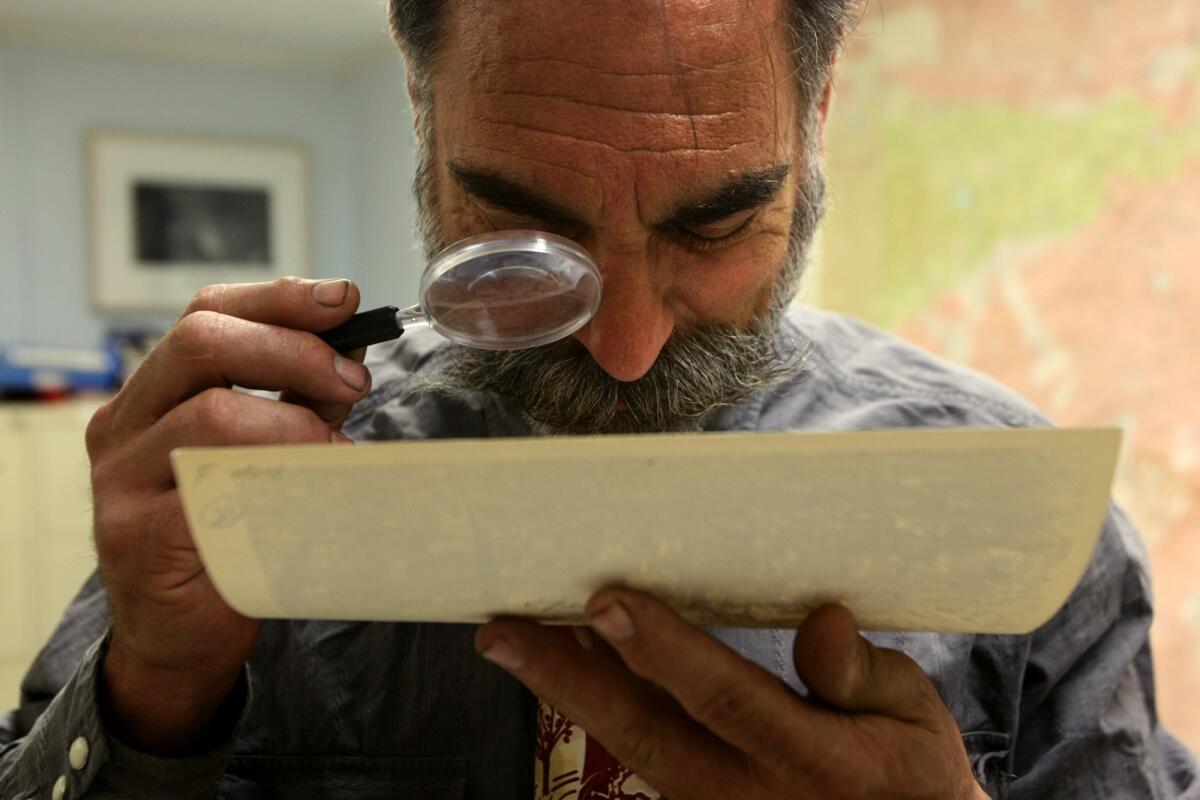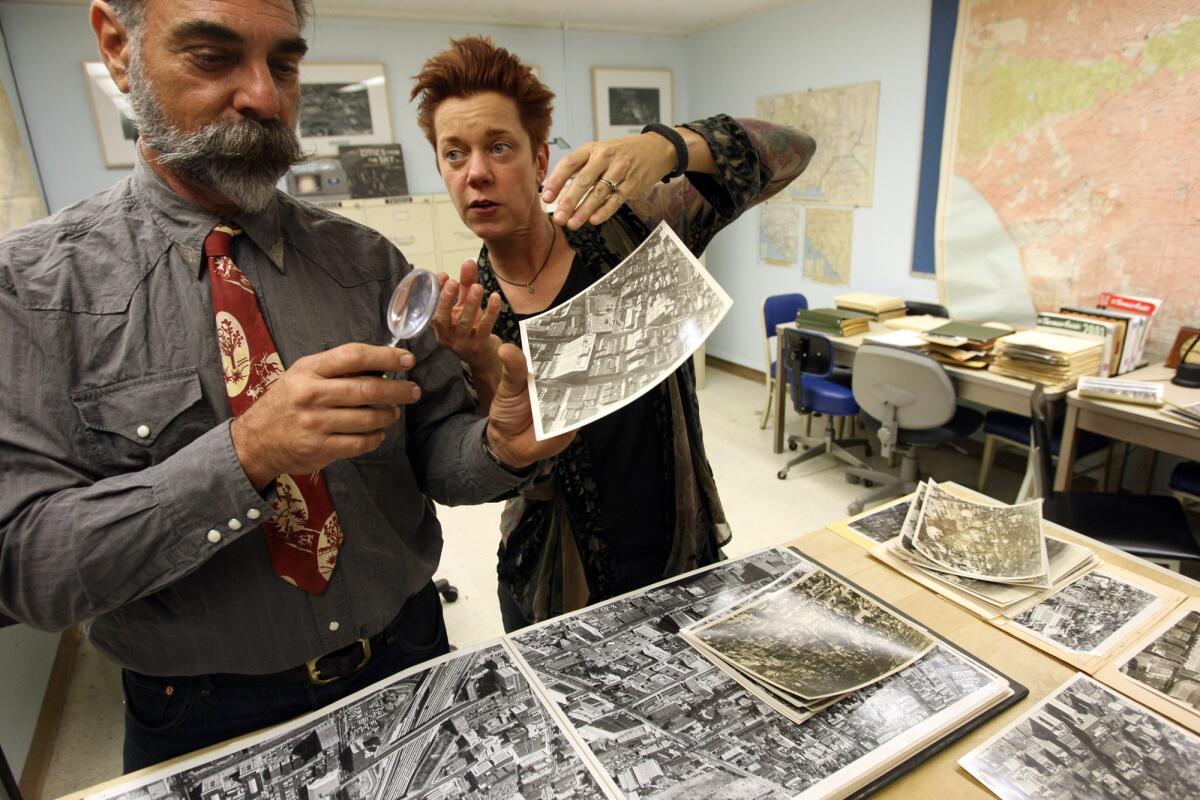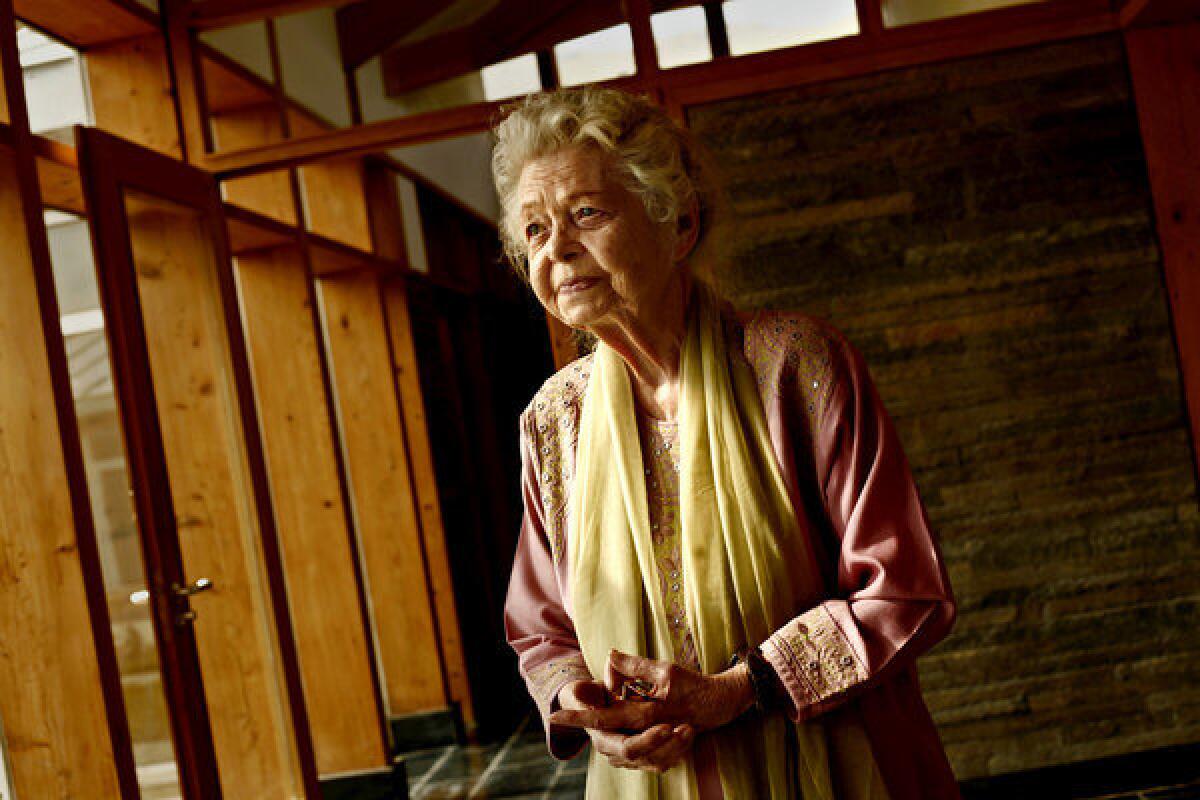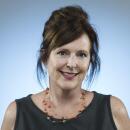Pair sheds new light on L.A.’s claim to neon fame
For years, Earle C. Anthony’s ‘Packard’ was said to be the first neon sign in America. But new research is suggesting otherwise.
- Share via
The brightly illuminated billboard was a traffic-stopping sensation in 1923 Los Angeles, a city just starting its love affair with automobiles. Sitting atop a downtown hotel, the sign was rimmed in glowing blue and spelled out "Packard" in radiant red letters at least 4 feet high.
People drove long distances to view this newfangled technology called neon at the corner of 7th and Flower streets. They called it "liquid fire." Congestion got so bad that the police were called in.
That's the popular recounting of how neon made its debut in America: With his Packard sign, Los Angeles businessman Earle C. Anthony was the first to use those candy-colored glass tubes, beating out everyone else in the country — including New York. For decades, the story has been widely accepted in neon circles as fact.
But is it true?
Academic Dydia DeLyser didn't set out to debunk anything when she decided to research the history of neon.
But that simple scholastic decision ended up launching a yearlong search that took DeLyser and her research and life partner, Paul Greenstein, into the bowels of Los Angeles institutions to track down newspaper articles, permits and building records.
It ended in a windowless room at UCLA where file cabinets held thousands of 8-by-10 glossies showing Los Angeles from the sky — and one "aha!" photograph.

On a recent day, DeLyser spread out a foot-thick stack of files on an antique rug in the rambling Lincoln Heights Victorian she shares with Greenstein.
She flipped open a MacBook and launched a slide show that carefully recounted their months of painstaking research.
DeLyser had already written histories of Bodie, the Gold Rush ghost town in the Sierra, and contributed to a book on early California tourism. In 2011, she helped put together an Emmy-winning documentary on pioneering stunt pilot Florence "Pancho" Barnes.
Neon's history in this country would be her next topic, she decided. Greenstein, a restorer of vintage neon signs, would help her with technical questions.
But right away, they ran into a problem. DeLyser couldn't find any original source materials to back up the Los Angeles-was-first claim. Stories of Anthony erecting the first neon sign kept popping up in newspapers and neon-industry publications, but there was no original-source attribution.
They kept digging.
The growing city was a frontier in many ways for both neon signs and outdoor advertising in general. Every businessman in the period who wanted to promote himself as modern got a neon sign, neon historian Tom Rinaldi said.
Anthony, the Packard dealer, recognized neon's potential early on. During a 1922 trip to Paris, he saw commercial signs illuminated by neon and mercury gases and was captivated. He ordered two or three "Packard" signs (the precise number is unsettled, as is the price) to be shipped to his dealership.
DeLyser was able to track that part of the story. But as she combed through city records, a different timeline emerged for when the Los Angeles sign went up.
She found a Los Angeles Building Department billboard permit application submitted by billboard company Foster & Kleiser seeking to enlarge a sign at the northwest corner of 7th and Flower streets. It would be electrified, the application specified.
The permit was signed in December 1924.

DeLyser and Greenstein pored over the archives of two photography companies that took aerial shots of the evolving Los Angeles landscape from 1918 to 1971. Anthony's "Packard" billboard wasn't there in 1922, or 1923 or 1924. Then, in a photo dated 1925, an electrified billboard appears on the hotel building's roof. And, in a photo taken from another angle, an illuminated "Packard" logo is just visible on the front of the sign. (Benjamin and Gladys Thomas Air Photo archive) More photos
She also scoured newspaper archives, looking for a story on the traffic jams around the magical new sign. She went through pages of news clippings carefully preserved in albums by the Earle C. Anthony company, now in the possession of a Santa Ana Packard club.
Nothing.
"Huh, that's funny," DeLyser said. "When I didn't find it, I thought, 'I'll have to dig harder.'"
She and Greenstein pored through the archives of two photography companies that took aerial shots of the evolving Los Angeles landscape from 1918 to 1971. The photos now reside in the Benjamin and Gladys Thomas Air Photo archive in the geography department at UCLA.
For days, DeLyser sat with a magnifying glass, going through photo after photo, zeroing in on buildings and streets, looking for evidence of the Packard billboard. It wasn't there in 1922, or 1923 or 1924. Then, in a photo dated Feb. 10, 1925, an electrified billboard appears on the hotel building's roof.
It shows up two months after the permit was taken out, DeLyser notes. And, in a photograph taken from another angle, an illuminated "Packard" logo is just visible on the front of the sign. DeLyser and Greenstein were elated.
"It pretty much proves that the supposed Earle C. Anthony sign at 7th and Flower could not have been the first neon sign," she said. "By 1925, there were neon signs in New York, for sure. It has to be that the whole story was wrong."

It's so frustrating that something like neon that had such a prominence in the landscape of this country has such murky origins."— By Tom Rinaldi
The discovery has ignited spirited debate among the legions of fans of the glowing signs and their backdrop to Los Angeles' noir period of the 1930s and '40s.
Eric Lynxwiler, who operates a popular neon "cruise" across Los Angeles, says he always ended the tour with a stop at the Packard Lofts in downtown, where a reproduction of Anthony's long-ago sign hangs over an entryway. He's had to change his tour as a result of DeLyser's findings.
"My spiel in the past couple of months is to tell the original story and then say that the story is changing, Lynxwiler said. "We've lost our bragging rights. But we've also lost a really good tale."
Rinaldi said the research, while compelling, poses more questions than it answers. If the first sign wasn't in Los Angeles, where was it? he asks. And who put it up?
"It's so frustrating that something like neon that had such a prominence in the landscape of this country has such murky origins," Rinaldi said. "It's not like with incandescent lights, where everyone knows who Thomas Edison is and it's all documented."
It's likely the story came from Anthony's press operation and was promoted by the auto baron himself, DeLyser said. It was first mentioned in a 1939 interview of Anthony in the Los Angeles Times and is repeated in subsequent press clippings and industry publications.
The origins of neon weren't really written about until the 1970s, and by then the Packard sign story was already ingrained in neon's historical narrative, Greenstein said.
"It seems the basis of the story was people's memories," he said. "And memory is not always precise."
DeLyser, a native Angeleno who lives part time in Baton Rouge for her job as a geography professor at Louisiana State University, is diplomatic.
"If we continue researching subjects, sometimes the story changes," she said. "That's what happened here."


Greenstein examines the photograph that proves L.A. wasn't the site of the nation's first neon billboard. But what city was? New York? Or even San Francisco? (Genaro Molina / Los Angeles Times) More photos
So where did the first sign go up?
Absent documentation, that historical nugget remains a mystery. But the researchers say neon was being used commercially in New York City by early 1924, a full year before the Los Angeles Packard sign went up.
Los Angeles neon enthusiasts aren't ready to cede their friendly rivalry to New York. They say a photo could still emerge showing that Anthony erected his Packard sign somewhere else in Los Angeles.
"I refuse to give it to New York. New York has enough," said Catherine Gudis, a UC Riverside history professor and expert on Los Angeles signage. "They don't need our California first."
DeLyser and Greenstein have a theory — one they can't yet prove. Another photograph they unearthed shows a "Packard" sign on an Anthony dealership. They dated the photograph to 1923, and the sign appears to be neon, they said.
But it wasn't located in Los Angeles. It was on Anthony's showroom on Van Ness Boulevard in San Francisco.
"I would love for Los Angeles to win," DeLyser said. "But I'd still rather have San Francisco win than New York."
Follow Catherine Saillant (@csaillant2) on Twitter
Sign up for Essential California
The most important California stories and recommendations in your inbox every morning.
You may occasionally receive promotional content from the Los Angeles Times.












